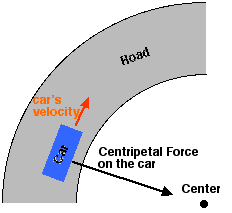
The diagram above shows a car (blue rectangle) going around a turn (top view). There must be a centripetal (center-pointing) force on the car.
|
|
|
The diagram above shows a car (blue rectangle) going around a turn (top view). There must be a centripetal (center-pointing) force on the car. |
We also know that forces are interactions between objects. Something must be exerting the centripetal force - it doesn't "just happen." What is exerting the centripetal force on the car? Well, it depends on the situation...